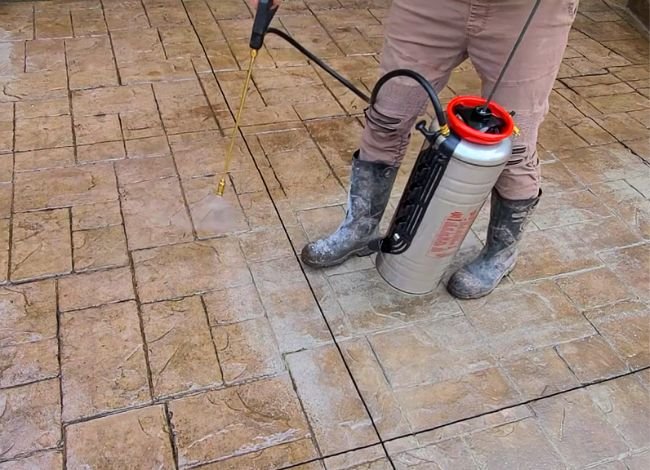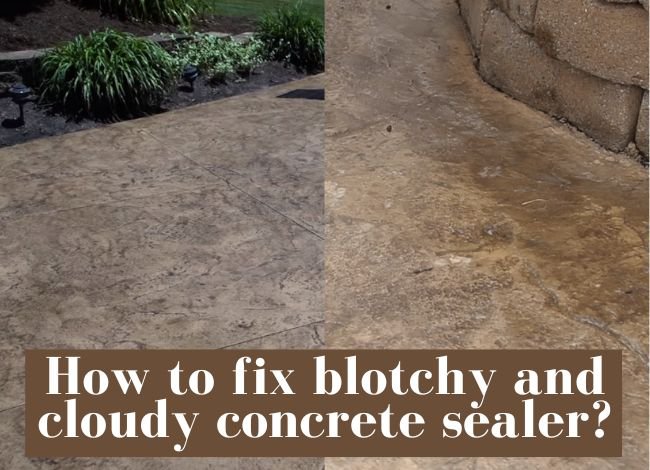Last Updated on April 21, 2025
Sometimes, homeowners encounter various issues after applying a concrete sealer. While many prefer to call in a professional for reapplication, the truth is—most sealer problems can be resolved with some simple steps. The key is to first identify the problem, understand its underlying cause, and then apply the appropriate solution. In this section, we’ll cover common concrete sealer issues, their causes, and how to fix them effectively without professional help.
How to Fix a Blotchy Sealer on Concrete
A blotchy concrete sealer refers to uneven coloring or patchy appearance on the surface, often resembling stains. This uneven finish can diminish the curb appeal of your concrete driveway or patio. A clean, uniform finish is crucial for a professional and aesthetically pleasing look.
To resolve this, follow these proven steps:
1. Wash and Remove Surface Stains
Cleaning is the most basic and essential step in restoring the appearance of your concrete. If your driveway sealer appears blotchy due to dirt, trapped moisture, or surface residue:
- Use a pressure washer to thoroughly rinse the surface.
- A light detergent or degreaser can be added to remove stubborn dirt or oil marks.
- Allow the concrete to dry completely before reassessing the blotchiness.
2. Use a Vinegar and Baking Soda Solution
For eco-friendly stain removal, vinegar and baking soda are an excellent DIY option.
- Mix equal parts white vinegar and baking soda with a small amount of water to create a paste.
- Apply the mixture to the stained or blotchy areas.
- Scrub with a stiff nylon-bristle brush in a circular motion.
- Rinse with water and let it air dry under direct sunlight.
This method is effective in removing mineral deposits or mild discoloration caused by trapped salts or residues.
3. Review the Sealer’s User Manual
Each concrete sealer product comes with a user guide or manual, either in the package or available online. It’s crucial to:
- Read all instructions, precautions, and curing times.
- Follow proper application methods as recommended by the manufacturer.
- Understand any incompatibilities with previous coatings or surface types.
Ignoring the user manual can lead to premature failure or improper finish.
✅ Pro Tip: Blotchy finishes often result from applying sealer to a damp surface, using excessive product, or not allowing proper drying time between coats. Always test a small area before full application.
Cloudy Concrete Sealant / Concrete Discoloration
Cloudy concrete refers to a condition where the concrete surface appears discolored or uneven but doesn’t necessarily have visible stains. This type of discoloration often results from improper sealing techniques, incompatible sealers, or environmental factors like rain or moisture during application.
Every type of concrete sealer comes with its own finish and color. For instance, if you’re applying an asphalt-based sealer to your driveway, especially one with coal tar, you’re likely expecting a rich black finish. Alternatively, if you’re using a chip seal for a textured effect, the result will differ significantly. However, if your asphalt sealer doesn’t yield the expected color or fades quickly, the sealing process likely wasn’t effective.
In some cases, the sealant might initially look fine but begins to discolor or cloud over time due to weather exposure or improper application.
How to Fix Discoloration in Concrete Driveways
Solving driveway discoloration starts with proper surface preparation and careful sealant application. Here are the steps to follow:
i) Allow Proper Drying Time
After applying the sealant, it’s crucial to let it dry thoroughly. The ideal temperature for drying is above 50°F (10°C). You should wait 48 to 72 hours before using the driveway to ensure the sealant sets properly. Using the driveway too soon can cause premature fading or blotching of the sealed surface.
ii) Clean and Seal Carefully
Before sealing, the concrete surface must be clean and debris-free. Any existing dirt, sand, or gravel can mix with the sealer and result in patchy or cloudy areas. Start with pressure washing to remove contaminants effectively.
When applying the sealer:
- Follow the manufacturer’s instructions carefully.
- Use a consistent application method, such as a roller or paintbrush.
- Avoid using too little sealer, which can lead to uneven coloring.
iii) Wash Discolored Concrete with Hot Water
If your concrete surface has already turned cloudy or discolored, try washing it with hot water. Unlike plain cold water, hot water helps break down surface residue and can restore the appearance of the sealer to some extent. For stubborn areas, consider using a mild detergent or a specialized concrete cleaner.
Frequently Asked Questions (FAQs)
Q: What causes a concrete sealer to turn white or cloudy?
A: This typically happens due to trapped moisture beneath the sealant or due to poor surface preparation. In some cases, water vapor from tap water creates pressure that lifts the sealer and separates it from the concrete surface. This can cause the area to appear white or hazy.
Q: What happens if I apply too much sealer to the concrete?
A: Applying excessive sealer can lead to moisture entrapment, causing adhesion failure, discoloration, and a blotchy finish. It can also result in the sealer peeling or turning cloudy over time. Always apply sealer in thin, even coats.
Final Thoughts
Using the right application methods and allowing proper drying time are key to preventing cloudy or discolored concrete sealant. When applied correctly, a driveway sealant can enhance both the appearance and durability of your concrete surface for years. Homeowners who take the time to clean, prep, and seal carefully are rewarded with a smoother, more professional finish.
For best results, choose a high-quality concrete sealer, apply under optimal conditions, and follow the manufacturer’s recommendations closely.

